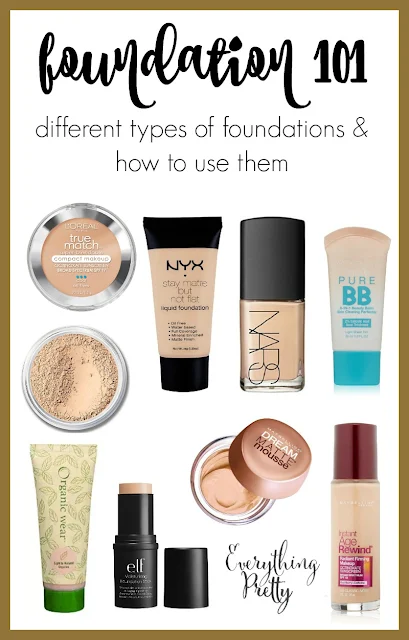One of the most frequent questions I get asked is what type of foundation is best? Powder, liquid, cream...which is best? Well, that depends on your skin tone, the amount of coverage you want, and your skin. If you have oily skin with large pores, you might use a different kind of foundation than your friend who has oily skin but doesn't have large pores. Keep reading, and I'll explain the different kinds of foundations and their pros and cons.
Tinted Moisturizer
Tinted moisturizers provide the least amount of coverage, so they are best for those with good complexions. It's nothing more than a moisturizer with a small amount of color added to even your skin tone slightly. Some tinted moisturizers have an SPF, but if yours doesn't, be sure to use one under it.
Tinted moisturizers are great for the summer months when your makeup is at risk for melting.
BB Cream
BB creams are an all in one moisturizer, primer, serum, sunscreen, and foundation. These have more coverage than a tinted moisturizer, but less than a separate foundation. These are also great for the summer months because they are light and have a sunscreen.
BB creams can correct some skin problems like reddish skin tone, large pores, and oily skin.
Sheer Foundation
Sheer foundation gives a very light coverage, but it is buildable if you need to hide imperfections or uneven skin tone. It's made with silicones, so it's best for dry skin. This formula is great for those with good complexions who don't need to cover redness or uneven skin tones.
Mineral Foundation
Mineral foundation is usually organic and natural, but some formulas can have fillers. Mineral makeup is made of crushed minerals. Powder is generally a no no for fine lines, but I don't find that mineral settles in my fine lines. I love mineral foundation because it has great coverage for being so light. It's my standard summer foundation.
Powder Foundation
Powder foundation is a pressed powder in a compact, so it's great for taking with you. It has a light coverage, but you can build it up for more coverage. It's great for women with oily skin because the powder absorbs excess oil.
Powder can setting in to fine lines, so it's not the best option for mature skin.
Oil-based liquid foundations have added moisturizers, which can help dry skin. The oil also temporarily plumps the skin, so it's great for fine lines and large pores. The added oil can be too heavy for oily skin.
Matte foundations are the counterpart to oil-based liquid foundations. They are great for women with oily skin. They dry quickly when you apply them, so it's best to use a foundation brush or beauty blender to apply them. You should also use a moisturizer before using a matte foundation so your skin doesn't get too dry.
Powder can setting in to fine lines, so it's not the best option for mature skin.
Oil-Based Liquid Foundation
Oil-based liquid foundations have added moisturizers, which can help dry skin. The oil also temporarily plumps the skin, so it's great for fine lines and large pores. The added oil can be too heavy for oily skin.
Matte Foundation
Matte foundations are the counterpart to oil-based liquid foundations. They are great for women with oily skin. They dry quickly when you apply them, so it's best to use a foundation brush or beauty blender to apply them. You should also use a moisturizer before using a matte foundation so your skin doesn't get too dry.
Whipped Foundation
Whipped foundations are liquid formulas with air whipped in to make them light and smooth. They feel weightless and have a matte finish. Since it goes on so smoothly, it's great for dry or mature skin because it doesn't cake up on your skin.Stick Foundation
Stick foundations have the heaviest coverage of any foundation, so they are great at covering up redness, under eye circles, scars, and blemishes. Since they are so thick, they are also prone to giving you cake face. You can use a stick foundation on blemishes or small areas and use a different type of foundation on your entire face. If you have fine lines, avoid stick foundation because it can settle in the lines and make them appear bigger.
If you love this post, then you'll love these posts:
 |
| How to Use Color Correcting Concealer |
 |
| Types of Concealer |
 |
| Eyeliner 101 |
 |
| Lip Liner 101 |
 |
| How to Use Bronzer |













